Tamir Rice
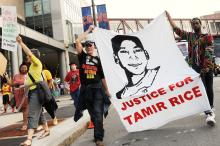
An Ohio police officer who fatally shot a black 12-year-old boy in 2014 was fired on Tuesday following an internal investigation, city officials said. Timothy Loehmann, a rookie with the Cleveland Division of Police, shot Tamir Rice, who was playing in a playground with a toy gun that fired pellets.

It would be much easier to let the face of the tomb be a scriptural story, so we could talk about terror and grief at arm’s length. But if we strip the story of humanity, we have no recourse but to fall into Christian platitudes that have no resilience in the face of real pain and grief.

A 13-year-old boy was shot and killed by an officer in Columbus, Ohio, on Sept. 15, after he allegedly brandished a BB gun as police attempted to arrest him, the Columbus Division of Police announced this morning.
The officers were responding to a report of an armed robbery in the area. Tyree King, the 13-year-old, was thought to be one of multiple suspects.
The name of the police officer who shot and killed King has not been released, however it was revealed that he has been a police officer for nine years.
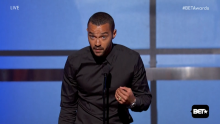
Best known for his role in "Grey's Anatomy," Williams stole the show on a night featuring a surprise performance by Beyoncé and Kendrick Lamar.
While I am no legal expert on the details of the court decision yesterday or whether the charges against him and each of the other officers were carefully made or effectively prosecuted, nor a spiritual expert on Nero’s motives, nor an administrative expert on Baltimore police training, one fact continues to remain clear: No one has yet to be held accountable for Freddie Gray’s death who was alive and well before being detained and put into that police wagon.
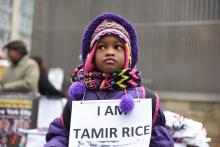
The City of Cleveland has agreed to pay $6 million dollars to Tamir Rice's family to settle a lawsuit against the two officers who killed 12-year-old Tamir Rice in November 2014.
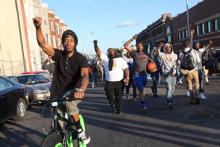
Here’s an irony: Standing at the memorial tree and experiencing a cloud of witnesses on this February day during Black History Month did indeed strengthen our resolve to keep fighting through the tears and the pain. We were mindful that on this particular day — Feb. 18, 2016 — the family of Sandra Bland would assemble later in the afternoon at the Houston Courthouse to hear response to their appeal for justice to be meted upon the Waller County sheriff and police. Our cacophony of voices called upon the Holiest of Holies to break the yoke of evil systems in which cronyism and political agendas thrived.

Some white Americans would like to try to “fix” the systemic racism that exists in our criminal justice, educational, economic, and even our religious institutions. But in order for real change to occur, our understanding of realities like white privilege must also move beyond the institutional and into the very personal.

On Nov. 22, 2014, a Cleveland police officer shot and killed 12-year-old Tamir Rice when he was playing with a toy gun in a public park. Over a year later, this past December, a grand jury declined to indict the two officers involved in the shooting.
Now, the city of Cleveland is charging his family for death-related medical expenses.

Influential faith leaders mourn following the decision not to indict the officer who killed Tamir Rice.
"Twelve seconds. One-fifth of a minute. Produces a lifetime of pain for a family and now eternal shame for America.”
— Rev. Dr. William Barber II, Forward Together, founder of the Moral Monday Movement, North Carolina

Black people’s humanity is still at question in the stories so many of us hear and tell in America. For many with a badge, a gun, and the legal shield of the state, black men and women — even black children — are not humans. Instead black bodies are threats and targets for rage, fear, and racially justified execution. When an officer of the law exterminates on the spot, we must ask ourselves what he was shooting. In his mind, Tamir could not have been a boy. He could not have been human. What did he see? And who bewitched him (and us) to “see things” when we are entirely sober?

Officer Timothy Loehmann will not face charges in the shooting death of 12-year-old Tamir Rice after a grand jury failed to indict Monday. The Cuyahoga County prosecutor’s office announced Monday that Loehmann's partner, Frank Garmback, will also face no charges. The news comes more than a year after Rice was killed while carrying a toy gun at a park in Cleveland.
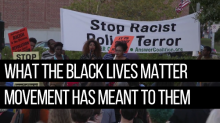
Sunday marked the 1-year anniversary of the killing of Michael Brown in Ferguson, Mo. Both in Ferguson, and across the country, the memorials and marches were held to remember those lost to police violence. Here in Washington, D.C., we attended one such demonstration and asked protesters what the #BlackLivesMatter movement has meant to them over the past year.

Please don’t fail to recognize this vital moment in American history: when our fellow citizens screamed for equality, marched for recognition, and pleaded for justice. Because someday the next generation will ask us: What did you do?
And so today we must ask ourselves: What are we doing? What are we seeing? What does this all mean?
Because the last few years within our country — a continuation of the past hundreds of years — have been socially jarring for a society that considers itself a modernized, technologically advanced, and morally superior nation

Men and boys of color are 21 times more likely to be fatally shot by the police than their white counterparts. Of the 1,217 deadly police shootings that occurred from 2010-2012, men of color between the ages of 15 to 19 were killed at a rate of 31.17 per million, while the rate for white males the same age was only 1.47 per million.
This pattern is not new. It is old and repetitive. And it is sickening.

THE GRAINY, STUTTERING surveillance footage shows police milling about, offering no medical assistance to the 12-year-old boy, Tamir Rice, one of them has just shot. They only spring into action when the boy’s older sister runs into the frame toward her brother. An officer tackles the girl, knocking her back in the snow, then cuffs her and puts her in the patrol car, only a few feet from her dead or dying brother.
This extended footage, released in January, and bystander cell phone footage from a few minutes later with audio of the sister wailing over and over “they killed my brother,” brought into my head the Good Friday spiritual “Were You There?” It was another moment, in months of unrest over police killings of black adults and children, when the question pressed in on me as a white person. “Were you there? Were you there when they choked my father dead? Were you there when they shot my son? Were you there when they killed my brother? Were you there?”
While books and other cultural works are no substitute or shortcut to the spiritual work of true repentance and detoxifying from cheap grace, they can be means of deepening understanding and finding the resolve to take action. Along with the film Selma, following are some of the artistic resources I’m turning to this Lent.
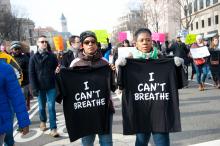
Maybe I am the only one wondering “What can I do?” as I watch and read the news of demonstrations throughout the country. I have a lot of excuses. I can’t go to the protests tonight because my son has a concert. I don’t coordinate the church service and announcements, so I can’t control what will and won’t be said. I’m on sabbatical so I won’t be a part of the conversations that I hope will happen between colleagues at meetings. But I hope I am not the only one wondering what can be, needs to be, ought to be done.
The videos are chilling – Eric Garner’s life is being choked out of him until he goes limp on the sidewalk and Tamir Rice is being gunned down, the police squad door barely opening as the officer drives by. The images of protests and protesters being tear gassed and throwing canisters back at police armed in riot gear remind me of the summer I spent in Korea, marching in protests against U.S. military presence. That was the summer I learned about wearing damp handkerchiefs near my eyes and over my nose to help with the sting of tear gas and how to wet the wick of a homemade Molotov cocktail before lighting and lobbing. A few years later in a hotel room in Indiana after a job interview, I watched protests and riots take over Los Angeles. Living with, wrestling with injustice day in and day out is a bit like a kettle of water just about to hit boiling. At some point, the water boils, the steam is released.
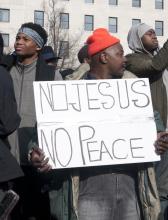
“Excuse my ignorance, I thought I was a free black man.”
“I’m 11 [years old], I matter.”
“You can choose to look away, but never again can you say you didn’t know.”
“How many times do we have to protest the same [s**t]?”
“White silence is white violence.”
“We have nothing to lose but our chains.”
These signs, and many others, lined the horizon of Pennsylvania Avenue on Saturday in Washington, D.C. In a ‘Justice for All’ march organized by Al Sharpton and the National Action Network, thousands of protesters gathered to protest police actions that have resulted in the deaths of unarmed young black men across the United States.
After marching from Freedom Plaza to the U.S. Capitol, protesters listened to speakers from national racial justice organizations address some of these most recent acts of police brutality.
Al Sharpton sought to draw attention to the diversity present on the streets.
“This is not a black march or a white march. This is an American march for American rights,” he said.
Indeed, the black community was not alone in speaking up against police brutality. One Latina activist encouraged her Latino brothers and sisters to “voice their pain” from police harassment and “come forth and unify with the African American community so we can be strong together.”
“¡Ya Basta!” she concluded. [“Enough is enough!”]
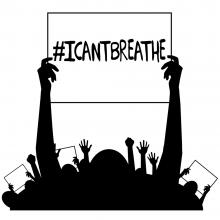
Our nation stands at a crossroads moment as the simmering crisis around policing and our justice system reaches a boiling point. Recent cases of police violence in Ferguson, Cleveland, and now Staten Island have stirred an awakening around what is increasingly understood as a pervasive and pernicious problem in America in which black lives are too often treated differently when it comes to police accountability and criminal justice.
Last week, I had the privilege of participating in a retreat with other faith leaders convened by Sojourners to learn about and make common cause with the ongoing efforts to seek justice in the tragic death of Michael Brown Jr. We spent a day talking to local faith leaders and young activists. We visited the memorial site in Ferguson where Brown was tragically killed and the streets where 120-plus days of protest have ensued. While it was heart-wrenching to stand and pray at the site where Brown was killed, I left the two days filled with a resilient sense of hope based on our conversations and interactions with a cross section of young people, most in their early to mid-20s, who embody modern-day freedom fighters. I hope we as a nation can listen to their voices and come to know their stories as we seek answers around what our response should be.
Young activists at the center of the protest movement in Ferguson are refusing to accept cosmetic change or symbolic commitments; instead they are fighting to transform their community and our nation so that neither punishment nor privilege will be systemically or viciously tied to the color of our skin. In the process, these young activists are picking up the broken pieces of the civil rights struggle. Their courage, willingness to sacrifice, and bold vision gave me a great deal of hope for what America can be.

For the past several years, I have been less outwardly celebratory during the Christmas season. No wreaths, trees, or bad sweaters for me; I have chosen to be introspective during the end of the year season in order to keep my focus on the true meaning of Christmas. This has become increasingly difficult, as the process of commercializing the celebration of Christ’s birth begins right after Halloween and extends itself until after the nation celebrates the life of Dr. King in January. This year, it has been increasingly difficult to concentrate on this Season of Advent in light of all of the anger and protests going on around the country. The protests over grand jury decisions in both the Michael Brown (Missouri) and Eric Garner (New York) cases and the heartbreak and anger over the deaths of Tamir Rice (Ohio) and Akai Gurley (also in New York) have served for me as a reminder that we need to rally around life.
Many of those critical of the decisions in these cases say that black lives do not matter, and there is some validity to that in a nation that has never truly been delivered and healed from the effects of chattel slavery. Those on the other side say that these cases have gone to the judicial system and that the system should be respected, the issue dropped, and that personal responsibility is the mindset that will move the nation forward. While there is truth in both of those opinions, I am led to think of the joy the families of these dead men and boys must have felt at their birth – a moment of endless possibilities – and I also think of the finality – the end of chances represented by their deaths.